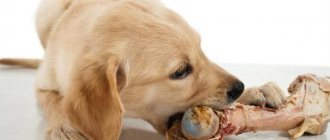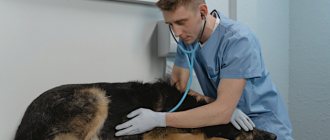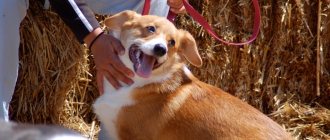Any dog twitches in its sleep; an inexperienced owner may find this phenomenon disturbing. In some situations, experiences are far from groundless, but in order to draw the right conclusions, you need to be able to distinguish sleep from fainting, tremor from tics, and twitching from convulsions.
Important! If your pet trembles violently in his sleep or you cannot wake him up, call a doctor immediately!
Why is the dog shaking?
Trembling can occur in a dog as an independent phenomenon or be a symptom of pathology. Depending on the accompanying symptoms, it is important to identify the true cause of the problem in time and take appropriate measures.
Environmental factors
Pets spend most of their lives in comfortable conditions. In winter, during a walk, they have a defensive reaction - trembling. Thus, the body tries to warm up by releasing heat during rapid muscle contraction. This condition is more often observed in short-haired breeds, so they should wear special insulated suits.
Swimming in cool water causes shivering for the same reason. After water procedures, the pet must be dried with a towel (or a hairdryer, but with caution) and sent to a warm room.
Psychological factors
When experiencing extreme stress, a dog will tuck its tail and tremble. Some may whine, bare their teeth, hide, or flatten their ears. This reaction can be observed in various unpleasant situations for the pet:
- visiting a veterinary clinic (or having a doctor come to your home);
- expectation of punishment;
- travel in transport;
- meeting other animals;
- sharp loud sounds (for example, during the launch of fireworks).
In some overly emotional dogs, positive emotions can cause a similar reaction. For example, when meeting the owner or before going for a walk, the pet rejoices and constantly shakes.
If the trembling is associated with a psychological factor, the problem goes away only after eliminating the stressful situation. It is possible to use sedatives: Fitex, Stop Stress, Fospasim.
Low blood sugar
Hypoglycemia is a pathology in which the level of glucose in a pet’s blood sharply decreases. For dogs, the lower limit is 3 mmol/l. Often hypoglycemia is a symptom of an underlying disease or the result of improper feeding and maintenance.
In this state, the following features are noted: the dog becomes lethargic, trembles, while the nose remains cold. In severe cases, the animal may lose consciousness and convulsions begin. If help is not provided in time, death occurs.
As a first measure, a glucose solution is injected intravenously (or subcutaneously) into the pet. The animal is placed in a warm place until its general condition stabilizes. It is important to establish the root cause of why the blood sugar level has dropped and take measures to eliminate it.
Poisoning
A state of general severe intoxication occurs when poisons, toxins, and various chemicals enter the pet’s body. Symptoms include:
- lack of appetite;
- frequent bouts of vomiting (white foam, food debris, blood);
- depressed state - the dog lies and shakes;
- diarrhea;
- hard breath;
- convulsions.
Treatment for poisoning should only be provided in a veterinary clinic due to the high risk of death. Therapy includes the introduction of an antidote (if available) and symptomatic measures.
Hormonal imbalances
Hormonal imbalance in the body causes many dangerous symptoms, including the condition when the dog is trembling. The reasons may be the following:
- Hypothyroidism is a pathology that develops with a lack of thyroid hormones. The causes of this condition can be congenital or occur during the pet’s life (thyroid tumors, unbalanced feeding, infectious diseases, etc.). Symptoms of the disease differ from the severity of the course: apathetic state (the animal walks poorly, decreased appetite, refusal to play), paralysis of some muscles, disturbances in the secretion of the lacrimal and salivary glands, etc. For treatment, the doctor individually selects the dosage and procedure for using hormonal drugs, which will replenish the deficiency in the body.
- Eclampsia is a condition associated not so much with a hormonal disorder, but with a sharp decrease in calcium in the blood. The problem occurs due to improper feeding of the pregnant female or after childbirth. Symptoms are: the dog is trembling and breathing rapidly with his tongue hanging out; body temperature rises, vomiting appears, and salivation increases. As the problem worsens, the seizures become more frequent and the pet may die. The condition requires special attention and immediate veterinary care. The doctor administers calcium supplements by injection and makes further adjustments to the female’s diet.
Viral diseases
Chills in a dog can be a symptom of an infectious disease. An acute course is observed in puppies under one year of age and animals with weakened immune systems.
The most common viral diseases of dogs.
| Disease | Main clinical manifestations | Therapeutic measures |
| Parvovirus enteritis | The pet refuses to eat, foul-smelling almost black diarrhea appears, vomiting, elevated body temperature, the dog trembles and arches its back due to acute pain in the abdominal wall | Intensive symptomatic therapy is carried out with constant monitoring of the animal’s condition |
| Carnivore plague | Symptoms depend on the form of the disease:
| The choice of treatment depends on the form of the disease. Apply:
|
| Infectious hepatitis | Increased body temperature, vomiting mixed with bile, yellowness of the mucous membranes, lack of appetite, apathetic state, the dog’s hind legs are shaking due to general weakness | Apply:
|
| Aujeszky's disease (pseudorabies) | The body temperature is elevated, the animal does not eat anything, nervous disorders are observed: the pet is hiding and trembling, breathing is difficult, itching appears, sleep disturbances | Due to the rapid progression of the disease, no effective treatment has been developed. |
To prevent the most dangerous viral diseases, vaccinations are carried out annually.
Parasite infestation
Helminths cause a number of changes in the body. Frequent symptoms are perverted or excessive appetite, gradual loss of body weight, dull coat, and dandruff. This sign, when the dog trembles when inhaling, may indicate infection with heartworms, hookworms and other forms, the larvae of which infect the lungs or heart.
Expert opinion
Kuzmenko Olga Olegovna
Information about the expert
Ask a Question
Deworming is carried out once every 3-4 months. The drug is selected based on its spectrum of action and ease of use. If the presence of worms is confirmed, anthelmintics are given at least twice with an interval of 2 weeks.
Diseases of internal organs
Almost any pathology of the internal organs can cause the dog to whine, tremble, and refuse food and water. This reaction of the body is associated with painful sensations, intoxication, dysfunction of entire systems, resulting in an imbalance of vital elements.
Possible reasons:
- Diseases of the urinary system (urolithiasis, acute renal failure, cystitis). The dog has painful urination and its hind legs tremble when standing. The color of the urine changes from cloudy yellow to brown, and the body temperature is elevated. Treatment depends on the course of the pathology and includes the use of antibacterial, anti-inflammatory, hemostatic agents, and diet correction.
- Disorders of the digestive tract and liver (gastroenteritis, enteritis, colitis, hepatitis, etc.). The main symptoms are diarrhea or constipation, vomiting (of food, bile), the dog is shivering, while the temperature is slightly elevated or within normal limits, and there is no appetite. Therapy is symptomatic, the pet is transferred to dietary food.
- Problems with the nervous system (epilepsy, encephalomyelitis, spinal cord diseases). Manifestations can be different: loss of coordination, unusual habits (chasing the tail, biting fur, etc.), the dog shakes in its sleep, behavior changes. Treatment is carried out strictly individually after diagnosis and an accurate diagnosis.
- Cardiac and respiratory disorders (chronic pathologies, acute inflammatory reactions). The animal quickly gets tired from physical exertion, the mucous membranes acquire a bluish tint, the dog trembles when inhaling, breathing is difficult, coughing and shortness of breath are noted in a calm state. After diagnosing the pathology, specific therapy is prescribed, sometimes lifelong.
- Pathologies of the musculoskeletal system (arthritis, arthrosis, dysplasia, etc.) are accompanied by a decrease in mobility; depending on the localization of the process, the pet’s front or hind legs shake, lameness and an unsteady gait appear. Therapy includes taking anti-inflammatory, painkillers, and chondroprotectors.
Trembling after vaccination
Modern vaccines do not pose a risk to animal health. Some animals may exhibit only an individual reaction, which goes away on its own within 1-2 days. In such cases, a decrease in appetite is noted, the pet trembles, activity decreases, and sleep time increases.
Trembling as a feature of the body of certain breeds of dogs
Owners of small breeds of dogs note that their pets tremble more often than others. The main reasons why this happens are the characteristics of their temperament (they are more susceptible to stress) and accelerated thermoregulation (in cold conditions, in order to warm the body faster, the muscles contract, releasing heat).
How do dogs' dreams differ from human dreams?
With the advent of technology that allows one to monitor brain activity during sleep, experiments on dogs were continued. With their help, it was possible to prove that dog dreams are different from human dreams. They are brighter, more dynamic, and quickly replace each other. Thus, the deep sleep phase in a person can last about one and a half hours. During this time, he manages to view the whole story. In dogs, it takes on average 20-25 minutes, and the dream consists of 2-3 pictures that quickly replace each other.
Interesting! In small breeds of dogs, sleep phases alternate more often than in adults. So, in a toy terrier this can happen every 10 minutes, in a Great Dane - every hour.
Scientists are also inclined to believe that during sleep, animals can not only see and hear, but also smell. This is evidenced by the fact that they often twitch their nose in their sleep, as if sniffing at something.
In small breeds of dogs, sleep phases alternate more often than in adults
Causes of trembling that you don’t need to worry about
- Behavioral peculiarity of males. During a walk, when the pet sniffs the female or the marks of other animals, you can observe how the dog’s lower jaw shakes. The reasons why such a reaction occurs are the physiological characteristics of the sense of smell and taste.
- Trembling after a haircut is a normal reaction, since the body does not have time to quickly rebuild the process of heat regulation.
- If your dog is trembling in his sleep, but there are no longer any alarming symptoms, this may be due to processes occurring in the brain during rest. Animals dream and can exhibit various reactions.
How to help your pet
Having figured out why the dog is trembling, you need to quickly help it. If there is nothing dangerous, help from the owner will suffice. But if you suspect a pathology, you need to consult a veterinarian.
How to eliminate harmless tremors
If you are sure that the tremor is associated with physiological factors, then you can cope with the situation yourself. A frozen dog should be warmed up - wrapped in a blanket and given warm broth to drink. If you have a breed with short hair, then do not forget to buy warm clothes for autumn and winter walks. You should not take your pet out into severe frosts for a long time - a few minutes are enough to relieve itself.
Make sure that the animal does not experience strong disturbances. An older dog's jaw may shake during or after eating - this is normal.
During the heat period, try to be outside with your dog as little as possible. Ask your veterinarian for advice - he may recommend herbal sedatives.
What to do if your dog is shaking?
- At low temperatures, wear special insulated clothing on your pet.
- Trembling after the operation is a consequence of the administration of anesthesia. The drugs used reduce thermoregulation, so the animal is placed in a warm room until recovery.
- Before an expected stressful situation, the animal is given sedatives in advance.
- Calm and pet your pet if he is shaking.
- If other symptoms appear, be sure to contact your veterinarian.
When to worry
In some cases, movements during sleep indicate health problems. The owner should be wary of:
- trembling of the head, in the paws or in the whole body at once;
- convulsions;
- active strong pushes with paws;
- lethargy immediately after waking up.
Movement during sleep may indicate health problems
These signs may indicate serious health problems. It is worth taking a close look at your pet while he is awake to understand whether there is a need to contact a veterinarian. The following table will help you recognize the signs of the disease.
| Disease | Behavior during sleep | Other signs |
| Central nervous system disorders | Strong paw kicks, lethargy after waking up | Loss of coordination, lethargy |
| Hypothermia | Trembling, in some cases convulsions | Lethargy, tired appearance, fever |
| Heatstroke | Shiver | Lethargy, apathy, refusal to eat, fever |
| Viral diseases | Trembling, or in severe cases convulsions | Fever, thirst, lethargy |
| Poisoning | Convulsions | Lack of appetite, lethargy |
| Heart problems | Trembling, convulsions | Increased or slow heart rate |
If a dog actively moves its paws in its sleep, whines, or even growls, but behaves completely normally when awake, there is no need to worry. In her dreams, she experiences a whole storm of emotions that she cannot hide. So you can just watch your funny pet without interfering with his rest.
In his dreams, a dog can experience a whole storm of emotions
Anyone, even an inexperienced dog owner, has encountered the fact that a dog can lead a completely active life while sleeping. The pet can twitch its limbs (sometimes quite actively), shudder, whine, wiggle its ears, grin and even howl. Actually, there is a justified explanation for this behavior that will reassure the alarmed owners. However, there are a number of situations when a dog twitches in its sleep due to pathological conditions, and here a lot of excitement arises - the dog may need emergency medical care. How not to miss the first alarm bells and not to confuse your pet’s usual behavior with symptoms of illness?
Fear
Any scared or very anxious dog or puppy can shake, and again, some puppies are more prone and sensitive than others and therefore more likely to become nervous or fearful. Puppies go through a complex learning process during their first year of life, and they will have many firsts in terms of seeing, doing and handling new things - and some of them will probably be a little scary for them until they get to grips with everything. they'll get used to it.!
Even among adult dogs, some dogs will be more sensitive and prone to fear than others, which in turn can cause nervous tremors or fear.
“Shaking” dogs: characteristics of small pets - Yorkies, toy terriers and others
Yorkshire Terrier Owners of Yorkshire Terriers are not surprised that their pets often tremble.
This is a normal reaction to cold. The body of these animals is so small that to warm it, it is necessary to accelerate the blood flow, and trembling helps to avoid hypothermia. In addition to the Yorkie, the "shaky" breed category also includes the Spitz, Italian Greyhound and Chihuahua. To prevent these animals from freezing, their owners should not take them out for a walk without warm clothing. Share with friends!
Physiological phenomena
Trembling in dogs, especially small breeds, is a normal physiological phenomenon. The animal stops trembling as soon as the source that provoked this condition disappears. Let's look at the causes of natural tremors in dogs.
Sexual interest
During the mating period, males' sexual interest increases. Under the influence of hormones, the dog begins to shake when he sees a female. A hormonal surge in bitches, in turn, occurs during estrus.
Related article: How to recognize and treat Malassezia in dogs
Trembling due to a hormonal surge is not dangerous for animals. You need to wait until the period of attraction to the opposite sex passes. Please note that this phenomenon (we are talking about tremor) is not typical for castrated and sterilized animals.
Cold
One of the most common causes of chills in a dog is hypothermia. If you notice that the dog begins to tuck its tail and tremble, it’s time to end the walk and rush home.
Shivering as a result of hypothermia is possible not only during long walks in winter, but also after swimming. Tremors are most often observed in small or short-haired breeds.
Excitement or delight
According to experienced dog breeders, the dog may begin to tremble and whine in anticipation of something pleasant and exciting. So, seeing the owner after a long separation, the animal will squeal and shake joyfully.
Fear
Dogs, like people, can experience not only positive, but also negative emotions. Fear, nervous overexcitation and stress negatively affect the emotional state of a pet and manifest themselves in the form of chills, whining and a desire to hide.
There are dogs that are afraid of thunder during a thunderstorm, fireworks, sharp bangs and loud noises. Some breeders recommend doing nothing in such a situation and leaving the dog alone, others advise helping the pet overcome its fear.
Today, there are many different methods of raising and training animals that live at home and are not accustomed to the realities of the environment.
Circling in place and digging
Another strange behavior you may have observed when your dog is getting ready for bed is the habit of scratching the floor and spinning in place before lying down, even on a soft surface such as a bed or pillow. This behavior is rooted in the same nesting instinct that causes dogs to curl up. In the wild, their canine ancestors dug into the ground to soften it and create a sleeping den that provided them with extra protection and helped regulate their body temperature. They would also spin in place to compact earth, leaves, or grass mat on their bed to make it more comfortable. Why this instinct has survived for thousands of years and is still strong in domestic animals remains a mystery.
Viral hepatitis
Hepatitis is a very insidious virus that can be transmitted not only through direct contact with an infected animal. It is easy to become infected while walking, as the virus can remain active for a very long time. Typically, young animals are susceptible to hepatitis in the first year of life, but cases of the disease are known at a later age.
Viral hepatitis may be the reason why a dog is constantly trembling, since it primarily affects the animal's nervous system. Along with tremor, the dog experiences damage to internal organs and loss of coordination. In such cases, contacting the clinic is mandatory, and as soon as possible.
Cold
The most common reason why a dog's hind legs tremble or his whole body shakes is cold. If the dog is cold, shivering is a normal adaptive reaction of his body to the low ambient temperature. Animals of breeds such as Spitz, Chihuahua or Yorkie are susceptible to cold and react to it immediately. Shivering is an effective mechanism for protecting the body from hypothermia. To protect your pet from the negative effects of low temperatures, you need to take care of his comfort. When going for a walk, you should wear special clothes, and maintain a normal temperature in the house. These recommendations will be useful for those people who want to find out why their Yorkie dog is trembling.











